Department of Light Source and Lighting Engineering, Fudan University
Abstract: A brief introduction to the requirements for ceramic tubes for high-intensity discharge (HID) lamps; preparation of high-purity alumina powder; fabrication of cylindrical and non-cylindrical ceramic tubes; and development of transparent ceramic tubes for HID lamps The situation.
Key words: high intensity discharge lamp, ceramic tube forming method, high purity alumina powder, PCA material
As an arc tube material for HID light sources such as high pressure sodium lamps and metal halide lamps, the following requirements must be met:
(1) has a high light transmittance;
(2) can achieve hermetic sealing;
(3) It can resist the erosion of sodium and metal halides under high temperature and high pressure;
(4) low conductivity at high temperatures;
(5) Low evaporation rate at high temperatures;
(6) It has sufficient mechanical strength to withstand the thermal shock of the light switch.
Until the first half of the 1960s, GE invented polycrystalline alumina-PCA (Polycrystalline Alumina) ceramic tubes, quartz glass is the most important arc tube material. GE successfully manufactured high pressure sodium lamps with PCA. At the time their trademark was Lucalox (transLUCent ALuminium OXide). In the early 1990s, Philips invented ceramic metal halide lamps based on white light high-pressure sodium lamp technology. The quartz tube can withstand a working temperature of 1300K, while the ceramic tube can withstand a working temperature of up to 1500K, so the performance of the ceramic metal halide lamp is much better than the quartz metal halide lamp. Obviously, the quality of PCA is very critical for these high intensity discharge lamps. To this end, people have done a lot of research and development. In the following, a brief introduction will be made on the manufacture of cylindrical ceramic tubes, the formation of non-cylindrical ceramic tubes, and the case of transparent ceramic tubes.
1Manufacture of cylindrical ceramic tubes
The processing of cylindrical ceramic tubes consists of 3 steps:
(1) Preparation of high purity alumina powder;
(2) forming of a cylindrical ceramic tube;
(3) Sintering process.
1.1 Preparation of high purity alumina powder
The raw material purity of the alumina powder used to make the arc tube must be high, reaching 99.99%. Why is this high purity? Because as long as there are impurities, even if it is small, it will cause some undesired effects. For example, it causes discoloration of the powder; during the sintering process, irregular crystal grains are generated; the grain boundaries are separated, so that the impurities are easily moved to the grain boundaries, and the impurity concentration there is increased. In addition, in order to obtain a high-density pipe, the sintering activity of the powder is good. This requires the powder to have a specific morphological structure, specifically, the particle size is very fine (about 0.3 μm), and the particle size distribution is very concentrated.
The raw material of PCA, α-Al2O3, is obtained by burning aluminum sulfate ammonia (AlNH4(SO4)2.24H2O) containing crystal water:
AlNH4(SO4)2.24H2O→Al2O3+NH3+SOx
At 10000 C, a bulk of Al 2 O 3 (having a specific surface of 125 m 2 /g, a density of 0.15 g/cm 3 , a particle diameter of 0.02 μm) was first formed, and then converted to α-Al 2 O 3 at 1200 to 14000 C. Next, the powder of the group was further dispersed to obtain α-Al 2 O 3 powder having a density of 0.4 g/cm 3 , an average particle diameter of 0.6 μm, and a specific surface area of 6 m 2 /g.
Table 1 lists the characteristics of the high-purity alumina powder raw materials used by NGK Corporation of Japan.
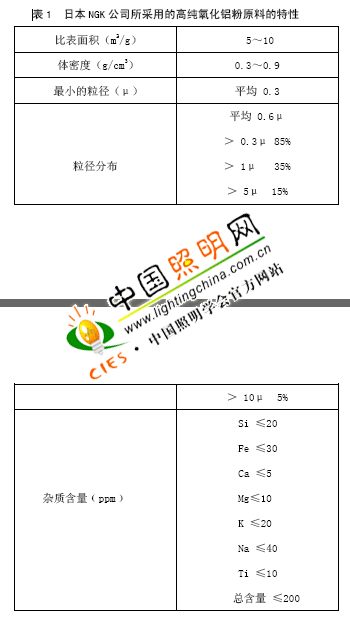
1.2 Formation of cylindrical ceramic tubes
The most common methods for producing cylindrical ceramic tubes are isostatic pressing (Isostatic Pressing) and extrusion forming (Extrusion). Additives such as alumina powder, binder, and magnesium oxide are thoroughly mixed with distilled water, and the resulting slurry is atomized and dried into a granular dry powder in a dedicated spray drying apparatus. Then, as shown in FIG. 1, the powder is filled between a hollow cylindrical rubber mold and a solid metal mold, and then the powder which is isostatically pressed into the mold is radially applied from the outside of the rubber mold with a high pressure liquid to form a powder. Dense cylindrical ceramic tube blank.

Figure 1 Schematic diagram of ceramic tube made by isostatic pressing
Extrusion method is to mix alumina powder, binder and additive with a liquid substance (or other additional liquid binder) into a dough shape, and then extruded through a metal mold to form a continuous elongation. Hollow or solid ceramic or ceramic rods. The process is shown in Figure 2. These long tubes and rods can be cut to the required length as required. This method of extrusion molding is suitable for continuous mass production.

Figure 2 Schematic diagram of extrusion molding
1.3 sintering process
The formed ceramic tube blank is finally sintered. Secondary sintering is usually used in the production process. The first sintering (pre-firing) is carried out at a relatively low temperature, the purpose of which is to remove the organic binder in the blank and to provide sufficient mechanical strength for subsequent machining, transportation and furnace loading of the blank. . In order to sufficiently volatilize the organic binder during calcination, the calcination must be carried out in an oxidizing atmosphere. The calcination temperature is about 12,000 C and the temperature is kept for 2 to 3 hours. The billet can be subjected to final high temperature sintering after being calcined. In large-scale production, high-temperature sintering is usually carried out by a tunnel-type hydrogen furnace with a length of about 20 m. Keep at a maximum temperature of about 18500C for 5 hours. The entire sintering process from warming to cooling takes about 35 hours. After high-temperature sintering, the size of the ceramic tube is reduced by 20% to 30%, and its density reaches 99.9% of the theoretical value, which is semi-transparent. After sintering, the physical properties of the finally obtained PCA material are listed in Table 2.

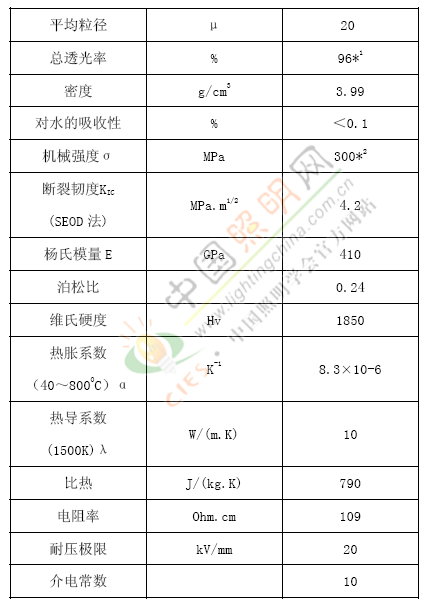
To obtain high quality PCA materials, the temperature, time, atmosphere and additive MgO content of the sintering must be carefully controlled. Figure 3 shows that the higher the sintering temperature and the longer the time, the higher the density. Figure 4 illustrates that as the density increases, the light transmission of the material also increases. However, as the sintering temperature increases, the size of the crystal grains also grows, and as a result, the strength decreases, as shown in FIG.
MgO is an indispensable dopant, which can effectively reduce the number of bubbles (see Figure 6), increase the density, and reduce the scattering of light. The typical content is 200-1000ppm. Now, some other dopants such as Y2O, La2O3, ZrO2 and CaO are added in addition to MgO. These dopants having a larger cation radius are easily separated at the grain boundaries, thereby greatly reducing the diffusion of halides into the grain boundaries in the metal halide lamp, and the lamp life is prolonged.


The above disadvantages can be better overcome by using a spherical or ellipsoidal structure. Many companies have done a lot of research on the forming technology of non-cylindrical ceramic tubes. The forming methods they use are mainly the following.
2.1 Blow Molding
This method uses an extruded cylindrical ceramic tube as a raw material. The ceramic tube is placed in a mold having the same inner shape as the designed arc tube. Under the pressure of the high pressure gas stream, the ceramic tube expands outward until it expands to the inner surface of the mold to form a predetermined shape, as shown in FIG. This method has a limitation on the diameter of the cylindrical tube used, and it is not possible to use a tube having a very small diameter as a raw material, otherwise the tube will be blown. Therefore, this method is only used to blow the middle part of the arc tube, and the two sides need to be connected with a ceramic tube of a smaller diameter for vacuum gas sealing.
Figure 8 ellipsoidal ceramic tube formed by blow molding
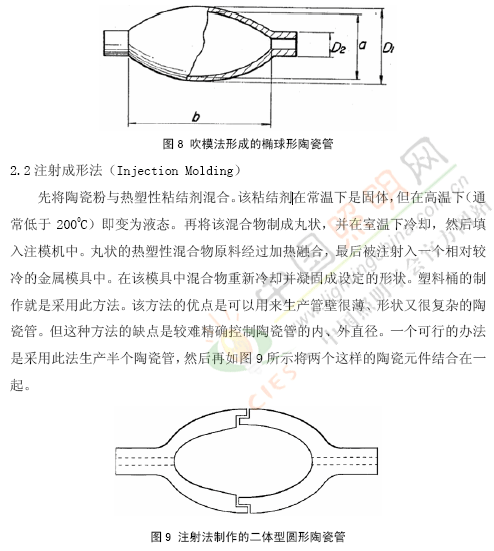
2.3 Slip Casting (Slip Casting)
First add ceramic powder and binder to the liquid (usually water) to form a low viscosity suspension
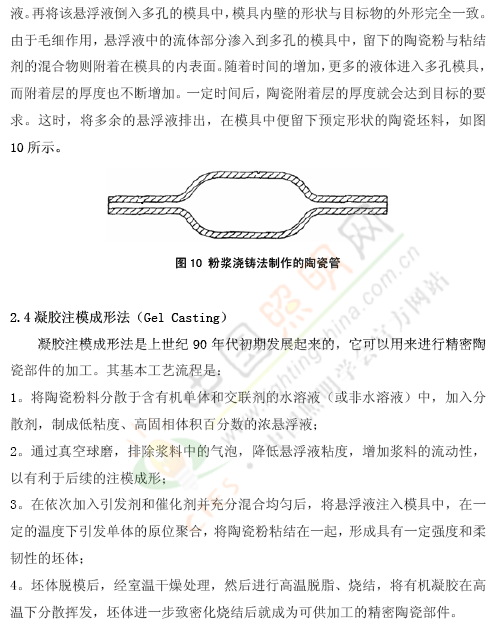

3 transparent ceramic tube
In addition to PCA, there are other translucent ceramic materials that can also be used as arc tubes for high intensity discharge lamps. For example, both spinel (MgAl 2 O 4 ) and yttrium oxide (Y 2 O 3 ) can be used as the material of the arc tube. They have a higher melting point and, because of their cubic crystal structure, have better optical properties. Mr. Waymouth used high-pressure sodium lamps made of yttrium oxide arc tubes to obtain higher light efficiency. For details, see "Light Source Principles and Design." The additives and sintering temperatures of these ceramic materials are listed in Table 3.

Since the PCA is translucent, the light source produced cannot be used in a spotlight such as a car headlight. In these cases, the light source must have a clearly visible high-intensity arc. In order to further improve the performance of metal halide lamps, scientists have conducted extensive research on transparent ceramics. It is found that Y2O3, Y2O3-La2O3, MgAl2O4, YAG(Y3Al5O12), AlON(Al23O27N5) and Dy2O3 are cuboidal crystals, and there is no scattering due to birefringence at the grain boundary. After polishing, it can be made transparent. material. PCA can be converted to single crystal alumina, ie sapphire, by a solid crystal conversion process (SSCC); through the HIP-Hot Isostatic Pressing process, micron-scale near-transparent can be formed. Crystalline alumina. Figure 13 shows the spectral transmittance curves of some of the above materials and quartz glass.
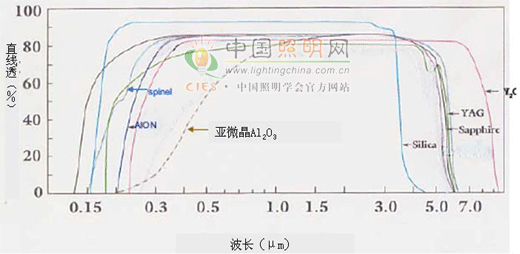
Figure 13 Spectral transmittance curves of several ceramic materials and quartz glass
Sapphire can be used to make high-intensity discharge lamps, and there are many benefits. First, it is more resistant to sodium attack; secondly, it can work at higher temperatures, and the HID lamp made with it has improved light efficiency; moreover, because it is transparent, the light output of the lamp is also higher. However, it has the disadvantage of anisotropy, the stress easily causes cracking or gas leakage, and sealing is also difficult. In addition, sapphire can only be made into a cylindrical tube and cannot be used to make a spherical HID lamp.
One of the most important achievements in the research of transparent ceramics in recent years is the transparent yttrium aluminum garnet YAG. It is much better than PCA in terms of optical and mechanical properties. It has been successfully used to make lights. However, its ability to withstand metal halide corrosion is still a problem. In order to reduce the risk of corrosion, it is necessary to study the filling of new materials in the lamp in the future. The mechanical strength and thermal expansion properties of aluminum oxynitride AlON are similar to those of PCA. The polished AlON has the same linear transmittance as sapphire. However, at temperatures below 16400 C, AlON can only remain stable over a small range of nitrogen partial pressures. Spinel (MgAl2O4) has a very high linear transmittance, but it is easy to react with sodium, and whether it reacts with rare earth halides remains to be studied. The sub-microcrystalline PCA material can be made by the sintering-HIP method. Because of its small crystal grain, the mechanical strength can reach 70% of the sapphire compared with the sapphire. This good mechanical strength and linear transmission allows it to be used to make non-cylindrical HID sources such as automotive headlamps. However, the sintering temperature of this new PCA material is lower than that of conventional PCA materials, and it is similar to the operating temperature of the lamp; therefore, when the lamp is operated at high temperature for a long time, its microstructure and stability of transmittance need further the study.
Osram-Sivania's GC Wei et al. made a spherical HID source as shown in Figure 14 using transparent polycrystalline yttrium oxide (Dy2O3), and the right side was the appearance of the lamp when it was lit. The outer diameter of the arc tube was 8 mm, the wall thickness was 0.5 mm, and the weight ratio of the iodide charged in the lamp was NaI: DyI3: HoI3: TmI3: TlI: CaI2 = 54.5: 6.6: 6.7: 6.3: 11.4: 14.5. In quartz glass or PCA
In the lamp, the color temperature is 3000K when such a filler is used; however, since the yttrium oxide strongly absorbs blue light (see Fig. 15), the light of the lamp is yellowish white, and the color temperature is lowered to 2500K. The color rendering of the lamp is very good, CRI ~ 90. The light efficiency of the lamp is 84 lm/W. The spectrum of the test lamp is given in Figure 16. The temperature rise of the xenon oxide lamp and the PCA lamp is compared in FIG. The former temperature rise is due to the strong absorption of yttrium oxide in the ultraviolet and blue regions.
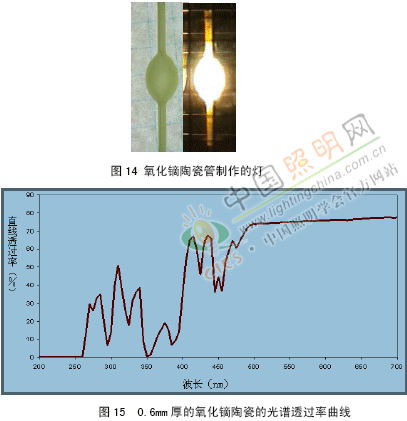

In the process of writing, I would like to express my deep gratitude for the help of Xu Yuefen of Yaming Bulb Factory Co., Ltd. and Wang Liang of HID Asia Development Center of Philips Lighting. Due to the limitations of the author, if there is any inconvenience, please correct me.
References [1] dr ir JJ de Groot and ir JAJM van Vliet. The High-Pressure Sodium Lamp. Philips Technical Library, 1986
[2] Fang Daoqi, Cai Zuquan. Principle and Application of Sodium Lamp. Shanghai Jiaotong University Press, 1990
[3] Koichiro Maekawa. Translucent Alumina Ceramics for Arc–tube of HPS Lamp.
Paper for invited lecture, 1994
[4] GC Wei. Transparent Ceramic Lamp Envelope Materials. LS-10 (2004) 169-170
[5] Wang Gang, Qi Fengyuan and so on. Review of precision ceramic gel injection molding process. Journal of Materials Science and Engineering, Vol. 21, No. 4, 602-606
[6] S. Miyazawa et al. New forming method of seamless vessel for ceramic metal halide lamp. LS-10 (2004) 159-160
[7]Theo GMM Kappen. Status quo of ceramic materials for metal halide discharge lamps. Journal of Physics D: Applied Physics, 38 (2005) 3033~3039
[8] Zhou Taiming, Zhou Ming, Cai Weixin. Principle and Design of Light Source (Second Edition). Fudan University Press, 2006
[9] JT Neil and GC Wei. A Survey of Fabrication Methods for Ceramic Metal Halide Arc Tubes. LS-11 (2007) 11-22
[10] Keiichiro Watanabe, Translucent Ceramic Envelope for HID Lamps. LS-11 (2007) 89-98
